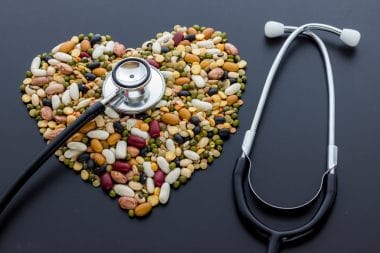“You are what you eat” has always been true — to be fit and healthy, you need to eat the right amounts of nutritious food. The notion that health is related to food originally appeared in 1826, when Jean Anthelme Brillat-Savarin wrote, “Tell me what you eat and I will tell you what you are.” The phrase resurfaced in the 1920s when Victor Lindlahr said, ‘‘Ninety per cent of the diseases known to man are caused by cheap food stuffs. You are what you eat.’’
Despite advanced agricultural and shipping practices that provide unlimited access to fresh, nutritious food, many consumers still have an unhealthy diet. Poor nutrition contributes to approximately 678,000 deaths in the United States each year, making an unhealthy diet and inactivity the leading causes of deaths. Consuming a nutrition-poor, energy-rich diet increases the risk for nutrition- and obesity-related diseases, such as heart disease, cancer, and type 2 diabetes.
The risk for certain diet-related diseases, such as hypertension, heart disease, cancer, and osteoporosis, increases with age. This means older adults are more likely than younger adults to need diet modifications to control disease.
However, rather than changing the older adult’s eating habits, the diet should always reflect their preferences. Furthermore, caregivers should never deny a specific food based solely on the individual’s age. Armed with advanced information about nutrition and its connection to health, caregivers and healthcare providers can create eating plans that are both appealing and nutritious to their older patients.
Attending a nutrition science online short course can give healthcare professionals and caregivers the information they need to create nutrition plans that help prevent or manage health conditions. Nutrition is a complex, but powerful tool that helps improve the quality of life in patients.
Diseases Associated with Poor Nutrition
Hypertension
Nearly half of all U.S. adults have hypertension, according to the Centers for Disease Control and Prevention (CDC), and less than 25 percent have it under control. Left untreated, hypertension can lead to a number of serious conditions, such as:
- Stroke
- Kidney failure
- Heart attack
- Heart failure
Nutrition plays a role in the development of hypertension. Sodium in food can stiffen and narrow blood vessels, which can decrease the flow of oxygen-rich blood to organs. The heart responds by working even harder, and this further increases blood pressure. Consuming foods rich in potassium, calcium, and magnesium can also lower blood pressure.
Obesity can increase blood pressure. Population studies suggest that at least two-thirds of hypertension cases are the result of obesity. Eating a low-calorie diet can help reduce hypertension associated with obesity.
Potassium improves fluid balance and helps the body maintain a normal heartbeat.
Heart Disease
Heart disease is the leading cause of death for both American men and women, claiming about 655,000 lives each year. Coronary artery disease is the most common type of heart disease; about 18.2 million adults aged 20 and older have the condition. Heart attacks are also common – 805,000 Americans have a heart attack each year.
Arteriosclerosis is a main nutrition-related cause of heart disease. This complex condition often develops as the result of smoking, cholesterol in the blood, high blood pressure, and high levels of sugar in the blood.
Eating a healthy diet consisting of fresh fruits and vegetables, whole grains, nuts and legumes, low-fat dairy, skinless poultry, and fish can help reduce the risk of heart disease.
Cholesterol
Cholesterol helps the body manufacture hormones, shape the sheaths that protect nerve fibers, create bile acids used for digesting fats, and strengthen cell membranes. The liver produces all the cholesterol a body needs, but animal products also contribute cholesterol.
Depending on how much cholesterol a person eats, the liver can produce up to 1,000 milligrams of cholesterol — if someone consumes 200 mg of cholesterol, the liver will only produce 800 mg. The average American consumes nearly 300 mg of cholesterol each day. While the liver should make less cholesterol to keep cholesterol levels under control, consuming excess cholesterol may exceed the body’s ability to control cholesterol levels.
Excessive blood cholesterol levels can trigger the development of plaques inside the arteries. Plaques become larger, which narrows blood vessels and eventually cuts off blood flow through arteries. Blocking arteries leading to the heart can cause heart attacks, while blocking arteries to the brain can cause strokes.
While the amount of dietary cholesterol affects cholesterol levels, the amount and kinds of fat consumed also play a role. Specifically, eating a diet rich in saturated fats tends to increase blood cholesterol levels, while consumption of polyunsaturated fats help lower it.
Cancer
The same high-fat diet associated with heart disease also may increase the risk of developing 13 different types of cancers, particularly colorectal cancer and breast cancer. Chemical reactions in body fat trigger the formation of substances that mimic female sex hormones, which may stimulate the growth of tumors. Foods that may increase cancer include processed meats, fried foods, dairy products, sugar and refined foods, and alcohol.
Type 2 Diabetes
More than 34 million people in the U.S. have diabetes, and 90 to 95 percent of them have type 2 diabetes. The condition develops as the result of insulin resistance, which allows blood sugar levels to rise to dangerous levels. Being overweight or obese increases the risk for developing type 2 diabetes. Making certain dietary changes, such as drinking more water, reducing sugar intake, and eating low-calorie foods can help.
For more information about nutrition and disease states, attend the nutrition science course. After all, you are what you eat.








Reply